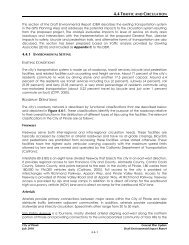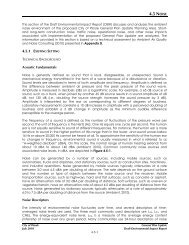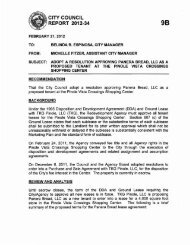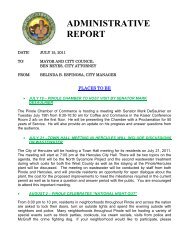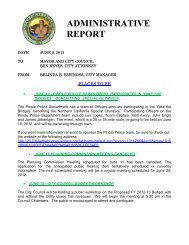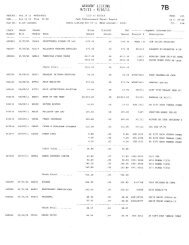CITY OF PINOLE Sewer Rehabilitation Program FY 07 – 08 PHASE 2
CITY OF PINOLE Sewer Rehabilitation Program FY 07 – 08 PHASE 2
CITY OF PINOLE Sewer Rehabilitation Program FY 07 – 08 PHASE 2
Create successful ePaper yourself
Turn your PDF publications into a flip-book with our unique Google optimized e-Paper software.
ASTM F1743 whichever is applicable) for all formula calculations.<br />
6. Manhole connection details.<br />
PART 2 <strong>–</strong> PRODUCTS<br />
2.01 GENERAL<br />
A. All materials and installation procedures provided by the Contractor for use in<br />
the CIPP installation process shall be equal to or exceed the requirements of<br />
Sections 5 and 7 of ASTM F1216 or ASTM F2019 Section 5 and 6, as is<br />
applicable.<br />
B. Wrinkles in the finished liner pipe which cause a backwater of one (1) inch or<br />
more or reduce the hydraulic capacity of the pipe (wrinkles which exceed five<br />
(5) percent of the pipe diameter) are unacceptable and shall be removed or<br />
repaired by the Contractor at no additional cost to the Owner. Wrinkles in the<br />
finished liner pipe that reduce the structural stability of the pipe are<br />
unacceptable. If a void between the wrinkle and the pipe exists, the Contractor<br />
shall repair or replace that section of the pipe at no additional cost to the<br />
Owner. Methods of repair shall be proposed by the Contractor and submitted<br />
to the Engineer for review.<br />
C. Contractor shall be responsible for control of all material and process variables<br />
to provide a finished CIPP possessing the minimum properties specified in<br />
ASTM F1216 or ASTM F2019, as is applicable and supplemented herein.<br />
2.02 MANUFACTURERS<br />
A. Approved CIPP liner manufacturers are LightStream by International Pipe<br />
Lining Technologies.<br />
2.03 CHEMICAL RESISTANCE<br />
A. DOMESTIC SEWAGE<br />
The chemical resistance tests should be completed in accordance with Test<br />
Method D543. Exposure should be for a minimum of one month at 73.4<br />
degrees F. During this period, the CIPP test specimens should lose no more<br />
than 20 percent of their initial flexural strength and flexural modulus when<br />
tested in accordance with Section 8 of ASTM F1216 or ASTM F1743,<br />
whichever is applicable, when subjected to the following solutions:<br />
Chemical Solution Concentration, percent<br />
Tap Water (pH 6-9)<br />
Nitric Acid<br />
Phosphoric Acid<br />
Sulfuric Acid<br />
Gasoline<br />
Vegetable Oil<br />
Detergent<br />
Soap<br />
PSP-16<br />
100<br />
5<br />
10<br />
10<br />
100<br />
100<br />
0.1<br />
0.1



